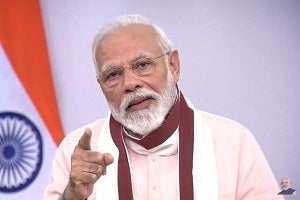Summary
Indian Prime Minister Narendra Modi’s recent economic package amounting to nearly 10 per cent of the country’s gross domestic product affirms a distinct change in India’s strategy to manage the COVID-19 pandemic in the country. The focus seems to be on converting a situation into an opportunity to reorganise and recharge a moribund economy.
A few days before the scheduled end of India’s extended lockdown on 17 May 2020, Prime Minister Narendra Modi addressed the nation on 12 May 2020 where he mentioned the importance of accepting the inevitability of the pandemic persisting longer and the efforts India needed to make so as not to be set back by the contagion. He announced an economic package amounting to nearly 10 per cent of the country’s gross domestic product (GDP) to overcome the damages caused by COVID-19. While alluding to extension of the lockdown beyond 17 May 2020, he emphasised on the operating conditions of the lockdown being markedly different from those prevailing till now.
The Prime Minister’s address affirms a distinct change in India’s strategy to manage COVID-19. The new strategy is driven by the realisation that the pandemic cannot be wished away. After seven weeks of stringent lockdown, the number of confirmed cases continues to rise. As on 12 May 2020, India had more than 70,000 confirmed cases of COVID-19. While much of India is virus-free, the hotspots in major states – Maharashtra, Delhi, Gujarat and Tamil Nadu – continue to report more cases.
While co-existing with the virus is inevitable for the foreseeable future, like most other countries of the world, India cannot afford to stay locked down for much longer. The difficult choice between saving lives vis-à-vis livelihoods has reached a point where the economic cost of COVID-19 has assumed staggering proportions. The Prime Minister’s emphasis on India needing to move ahead is an indication of the country no longer being able to employ a ‘wait and watch’ policy to let the virus run its course.
How serious are the economic ramifications for India? The most optimistic outlooks visualise GDP growth to drop to around 1.5 per cent. Some rating agencies, like Nomura and Goldman Sachs, forecast marginally positive to negative rates of GDP growth. There is little doubt about the economic contraction being sizeable, much worse than that during the global financial crisis of 2008, when GDP growth dipped to around three per cent. More ominous than the precise extent of the contraction is its impact on livelihoods.
The announcement of the lockdown in India from 25 March 2020 has been accompanied by displacement of migrant workers, who found themselves jobless as businesses stopped functioning. The plight of these workers highlights the damaging impact of the lockdown on the country’s workforce. Most of the displaced workers are part of the informal economy, engaged in industries like construction, real estate, transport, hospitality, retail and labour-intensive manufacturing like garments and food processing, which have been the hardest hit by COVID-19.
The International Labour Organization estimates around 400 million informal workers in India to be at the risk of plunging deeper into poverty. Combined with recent assessments like that of the Centre for Monitoring the Indian Economy reflecting 27 million young people between 20 and 30 years having become jobless in April 2020, the extent of the economic carnage raging in the labour market is easily discernible.
The acute joblessness in the country is compounded by the return of thousands of workers from overseas. The effect of such return would be felt on inward remittances. As the world’s largest recipient of worker remittances amounting to around US$80 billion (S$113.4 billion) in 2018, India’s balance of payments would be hit as receipts decline in the current account. At the same time, there is no certainty over when these workers will be able to return to the Gulf and other countries where they were working. They would add to the workforce and significantly augment its ‘idle’ segment, given that the current conditions are unlikely to produce alternative opportunities for them at home.
Prime Minister Modi has focused on converting the situation into an opportunity. By announcing a wholesome economic package to support all categories of businesses, he has emphasised on reviving local production. Given that several states are already implementing major market reforms, such as in labour and land, the current situation contains conditions that can spark a turnaround. This is the hope on which India has decided to gradually exit a stringent containment strategy. The latter, which will become selectively localised, will be accompanied by heavy push on kick-starting economic activity. This is no more a decision that India can afford to ponder on. The trade-off of saving lives by sacrificing livelihoods has become exorbitant. Perhaps the effort to contain the trade-off might reorganise and recharge the moribund economy in a desired decisive fashion.
. . . . .
Dr Amitendu Palit is a Senior Research Fellow and Research Lead (Trade and Economic Policy) at the Institute of South Asian Studies (ISAS), an autonomous research institute at the National University of Singapore (NUS). He can be contacted at isasap@nus.edu.sg. The author bears full responsibility for the facts cited and opinions expressed in this paper.
-
 More From :
More From :
-
 Tags :
Tags :
-
 Download PDF
Download PDF



